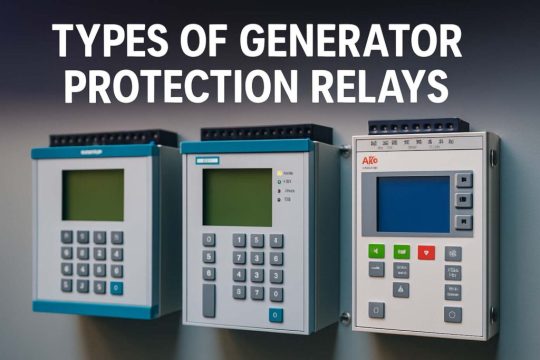#RelayTypes
Explore tagged Tumblr posts
Text
Types of Generator Protection Relays
Generators are one of the most crucial elements in power systems. They convert mechanical energy into electrical energy and supply power to homes, industries, and grids. Any damage or fault in a generator can lead to power outages and massive financial losses. To ensure uninterrupted and safe operation, generators are protected using specially designed relays. In this article, we will explore the types of generator protection relays with detailed technical explanations and practical examples.

Types of Generator Protection Relays
What Are Generator Protection Relays?
Generator protection relays are devices that detect abnormal operating conditions and isolate the generator from the system to prevent damage. These relays act as the first line of defense and are installed with strict adherence to IEC Standard for Protection Relays. They monitor parameters like voltage, current, frequency, temperature, and phase sequence to identify faults. Each relay has a specific function and is used depending on the generator rating, application, and fault scenario. These relays also support differential relay calculation when used for internal fault detection.
Why Are Protection Relays Important for Generators?
Generators are exposed to several electrical and mechanical stresses. These include overloading, overvoltage, overcurrent, unbalanced load, and internal short circuits. Without proper protection, these issues can cause irreversible damage. Generator protection relays prevent: - Rotor and stator winding damage - Insulation failure - Shaft misalignment and vibration issues - System-wide cascading failures Let’s now understand the types of generator protection relays in detail. Know more about Types of Faults in Transmission Lines
Types of Generator Protection Relays
There are several types of generator protection relays. Each relay has a defined role and application. The most commonly used relays are listed below with their technical purpose. 1. Overcurrent Protection Relay (51, 50) The overcurrent relay operates when current exceeds a set limit. It is essential in cases of short circuits and overloads. Two types of overcurrent relays are used: - Instantaneous overcurrent relay (50) – acts immediately without delay - Time overcurrent relay (51) – operates with intentional delay These relays detect abnormal current due to external or internal faults and help isolate the generator. This relay is closely related to the Types of Overcurrent experienced in any power system. 2. Differential Protection Relay (87G) Differential protection is one of the most sensitive forms of internal fault detection. It works by comparing the incoming and outgoing currents in the generator windings. Any imbalance indicates a fault within the zone. This principle is the same as the differential relay in transformer. However, in generators, the scheme is adapted to protect the stator windings. Differential relays trip only when a true internal fault is present, ensuring high selectivity and speed. Read the full article
#ElectricalProtectionDevices#ElectricalRelayFunctions#ElectricalSafety#GeneratorControlSystems#GeneratorProtection#GeneratorSafetyDevices#IndustrialPowerSystems#PowerSystemEngineering#ProtectionRelays#RelayTypes
0 notes
Link
Get to know the working principles of electromagnetic relays from the top relay manufacturers in India. Read this Blog for more insights! Visit - https://www.campuscomponent.com/blogs/post/what-is-electromagnetic-relay-and-its-types
0 notes